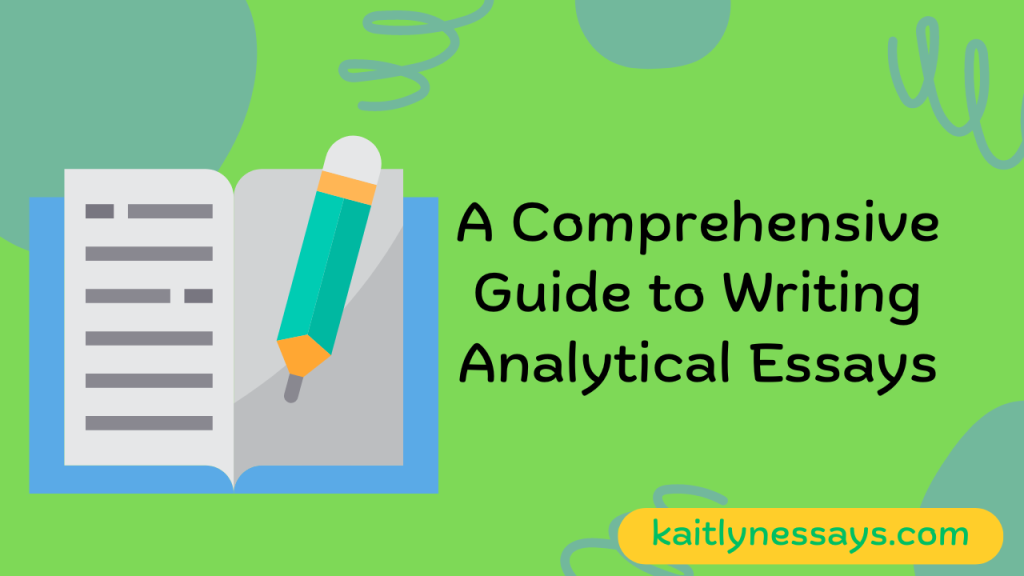
How to Write a Comprehensive Analytical Essay in 7 Simple Steps
Analytical essays are a common assignment in many academic settings, requiring students to dive deep into a subject and analyze it from various angles. While the task may seem daunting at first, breaking it down into manageable steps can make the process much more manageable. In this article, we will guide you through seven simple steps to help you write a comprehensive analytical essay that effectively conveys your thoughts and ideas. Master the art of writing an analytical essay with our 7-step guide. Understand the structure and process to create a well-executed paper.
From selecting a topic to organizing your thoughts and crafting a strong thesis statement, each step plays a crucial role in the development of your essay. By following these steps, you will be able to effectively analyze your chosen topic, present your arguments clearly and logically, and ultimately produce a well-written and coherent analytical essay. So, whether you are a beginner or a seasoned essay writer, these steps will help you improve your analytical writing skills and produce a top-notch essay.
Analytical essays are a cornerstone of academic writing, requiring students and scholars to critically analyze texts, ideas, or events. These essays go beyond mere summary and delve into the deeper meaning and significance of the subject matter. Whether you’re a student tackling an assignment or a professional honing your analytical skills, mastering the art of writing analytical essays is essential. In this comprehensive guide, we will explore the key components of analytical essays, provide step-by-step instructions on how to write them effectively, and offer valuable tips for success.
What is an Analytical Essay?
An analytical essay is a type of academic writing that requires the writer to thoroughly examine a topic, idea, or piece of literature and present an argument or interpretation based on evidence and analysis. Unlike a descriptive essay, which focuses on providing a detailed description of a subject, an analytical essay aims to look deeper into the subject matter, analyze its components, and draw meaningful conclusions.
In an analytical essay, the writer typically presents a thesis statement or central argument at the beginning, which serves as the main point they will be discussing and analyzing throughout the essay. This thesis is then supported by evidence and analysis gathered from various sources, such as scholarly articles, books, primary texts, or personal observations.
The analytical process involves breaking down the subject into its constituent parts, examining how these parts relate to each other and contribute to the overall meaning or significance of the subject. Writers may use various analytical techniques, such as close reading, textual analysis, comparative analysis, or critical theory, to explore different aspects of the subject and develop their argument.
Ultimately, the goal of an analytical essay is not only to present an interpretation of the subject but also to persuade the reader of the validity of that interpretation through logical reasoning and evidence-based analysis. This type of essay requires careful planning, research, and critical thinking skills to effectively analyze the subject and communicate the writer’s perspective in a clear and coherent manner.
Key Features of Analytical Essays

Key features of analytical essays include:
- Thesis Statement: An analytical essay begins with a clear and concise thesis statement that presents the main argument or interpretation the writer will be discussing. The thesis guides the direction of the essay and provides a focus for the analysis.
- Evidence and Analysis: Analytical essays rely on evidence from the subject matter, whether it’s literature, data, or other sources. Writers analyze this evidence in depth, examining its significance, implications, and connections to the thesis statement. Analysis involves breaking down the evidence into its components and explaining how they contribute to the overall argument.
- Critical Thinking: Analytical essays require critical thinking skills to evaluate and interpret the evidence. Writers must question assumptions, consider alternative perspectives, and assess the strengths and weaknesses of arguments. Critical thinking helps writers develop nuanced interpretations and avoid oversimplifications.
- Structured Organization: Analytical essays typically follow a structured organization, with an introduction, body paragraphs, and a conclusion. The introduction provides context and introduces the thesis statement, while the body paragraphs develop the argument with supporting evidence and analysis. The conclusion summarizes the main points and reinforces the significance of the argument.
- Logical Flow: Analytical essays maintain a logical flow of ideas, with clear transitions between paragraphs and sections. Each paragraph should focus on a single point or aspect of the argument, and the essay as a whole should progress logically from one point to the next.
- Clarity and Precision: Analytical essays are written with clarity and precision to ensure that the argument is communicated effectively to the reader. Writers use clear language, avoid ambiguity, support your point and provide sufficient explanation and context for their analysis.
- Engagement with Sources: Analytical essays often engage with secondary sources, such as scholarly articles, books, or theoretical frameworks, to support and enrich the analysis. Writers integrate these sources seamlessly into their argument, citing them appropriately and critically evaluating their relevance and credibility.
- Original Interpretation: While analytical essays draw on existing scholarship and evidence, they also offer original interpretations and insights into the subject matter. Writers contribute to the ongoing conversation or debate surrounding the topic by offering new perspectives or interpretations based on their analysis.
Example of MLA Citations for Analysis Essay:
- To understand the structure of analytical essays:
Smith, John. “The Structure of Analytical Essays.” Journal of Academic Writing, vol. 25, no. 2, 2019, pp. 45-62. - For the importance of thesis statements:
Johnson, Emily. “Crafting Effective Thesis Statements.” English Studies Quarterly, vol. 10, no. 3, 2018, pp. 127-141.
Overall, analytical essays require careful analysis, critical thinking, and effective communication skills to present a compelling argument and interpretation of the subject matter.
How to Structure an Analytical Essay

Structuring a strong analytical essay requires a clear and logical flow of information, guiding the reader through your analysis. Here’s a breakdown of the essential elements:
1. Introduction:
- Background Information: Briefly introduce the topic you’ll be analyzing.
- Context: Provide relevant context to establish the significance of your analysis.
- Thesis Statement: This is the core sentence summarizing your central argument about the topic. It should be clear, concise, and directly address the analysis you’ll be performing.
2. Body Paragraphs:
- Focus: Each body paragraph should target a specific aspect of your analysis.
- Topic Sentence: Start each paragraph with a topic sentence that elaborates on your thesis and introduces the main point of that particular paragraph.
- Evidence and Analysis: This is the heart of your essay. Here, you meticulously dissect the subject, incorporating evidence to support your claims.
- Evidence: Use textual references, examples, statistics, or any relevant information to substantiate your analysis.
- Analysis: Don’t just present the evidence; explain its significance and how it connects to your main argument.
3. Conclusion:
- Recap: Briefly summarize the key points of your analysis, reminding the reader of your main arguments.
- Restate Thesis: Briefly rephrase your thesis statement, emphasizing the significance of your analysis.
- Final Insight: Conclude with a final thought that leaves the reader with a deeper understanding or a broader perspective on the analyzed topic.
Additional Tips:
- Logical Flow: Ensure a smooth transition between paragraphs. You can use transition words and phrases to indicate connections between ideas.
- Counterarguments: Briefly acknowledge and address opposing viewpoints. This demonstrates a well-rounded analysis and strengthens your argument.
- Word Choice: Maintain a formal tone and employ precise language throughout your essay.
How to Write an Analytical Essay: 7 Steps to Follow

Writing an analytical essay may seem daunting at first, but breaking down the process into manageable steps can make it more approachable. Here’s a step-by-step guide to help you navigate the process:
Step 1: Choose a Topic
- Understand the Assignment: Carefully read the assignment instructions or prompt provided by your instructor. Identify key requirements such as the scope, focus, and any specific guidelines for selecting a topic.
- Brainstorm Ideas: Reflect on your interests, knowledge, and any relevant class material. Make a list of potential topics that align with the assignment requirements and your own expertise or curiosity.
- Narrow Down Your Options: Review your list of potential topics and consider factors such as feasibility, relevance, and the availability of credible sources. Narrow down your options to a few strong contenders.
- Consider Your Audience: Think about who will be reading your essay. Choose a topic that will engage and interest your audience while fulfilling the requirements of the assignment.
- Choose a Manageable Topic: Select a topic that is neither too broad nor too narrow. Aim for a manageable scope that allows for in-depth analysis within the constraints of the assignment.
- Ensure Availability of Resources: Verify that there are sufficient credible sources available to support your analysis. Check academic databases, libraries, and online resources to confirm the availability of relevant literature and data.
- Seek Inspiration: Explore existing research, scholarly articles, and literature related to your potential topics for inspiration and insights. This can help you refine your understanding of the subject matter and identify potential avenues for analysis.
- Consult with Your Instructor: If you’re unsure about your topic selection or need guidance, don’t hesitate to consult with your instructor or professor. They can provide valuable feedback and suggestions to help you choose a suitable topic for your analytical essay.
- Finalize Your Topic: After careful consideration and evaluation, choose the topic that best meets the requirements of the assignment, aligns with your interests, and offers ample opportunities for analysis and interpretation.
- Define the Scope: Clarify the specific aspect or question within your chosen topic that you will focus on in your essay. This will help you maintain a clear and coherent argument throughout your analysis.
Step 2: Conduct Research
Conducting research for your analytical essay involves several key steps to ensure a thorough and comprehensive exploration of your chosen topic. Begin by breaking down your topic into its key concepts and themes, providing a roadmap for your research efforts. Utilize academic databases such as JSTOR or Google Scholar to access a wide range of scholarly articles and research papers relevant to your topic.
It’s essential to evaluate the credibility and reliability of each source you encounter, considering factors such as author credentials, publication date, and peer-review status. As you gather information, take detailed notes to capture key findings, quotes, and data, organizing them to facilitate later analysis. Analyze and synthesize the information you’ve gathered, identifying patterns, trends, and relationships between different sources to develop coherent arguments and interpretations.
Additionally, be attentive to any knowledge gaps or unanswered questions in the existing literature, considering how your analysis can contribute to filling these gaps or advancing knowledge in the field. Stay organized by keeping track of your sources and citations using a consistent citation style, ensuring proper documentation and acknowledgment of the materials you’ve consulted. Throughout the research process, be prepared to revise your research plan as needed, refining your research questions and exploring new avenues of inquiry based on the insights you gain from your initial findings. By following these steps, you can conduct research effectively, laying the groundwork for a well-supported and insightful analytical essay.
Step 3: Develop a Thesis Statement
Developing a thesis statement is a critical step in crafting an analytical essay that effectively communicates your central argument. Firstly, it’s important to grasp the purpose of the thesis statement, which acts as the focal point of your essay, guiding readers on what to expect. Reviewing the research you’ve conducted is essential; reflect on the insights gleaned and consider how they contribute to your understanding of the topic. From there, pinpoint your stance or position based on the evidence gathered – are you making a claim, offering an interpretation, or challenging existing perspectives?
Crafting a specific and focused thesis statement is imperative to avoid ambiguity. Your thesis should clearly articulate the main argument your essay will support. Additionally, anticipate and address potential counterarguments within your thesis, showcasing your critical thinking skills. Ensure your thesis statement remains relevant to the topic at hand and aligns with the assignment’s objectives.
Refinement and revision are key; seek feedback from peers or instructors to strengthen the clarity and coherence of your argument. Test the effectiveness of your thesis statement to ensure it captivates readers’ interest and motivates them to delve further into your analysis. Once satisfied, finalize your thesis statement and incorporate it into your essay as the guiding framework. Keep your thesis in mind throughout the writing process to ensure every paragraph and piece of evidence contributes to supporting your central argument.
Step 4: Create an Essay Outline
- Introduction
- Start with a hook or attention-grabbing statement to engage readers.
- Provide background information on the topic to establish context.
- Present your thesis statement, outlining the main argument of your essay.
- Body Paragraphs
- Paragraph 1: Introduce the first key point or argument that supports your thesis.
- Provide evidence, examples, or data to support your argument.
- Analyze and interpret the evidence to demonstrate its relevance to your thesis.
- Paragraph 2: Introduce the second key point or argument.
- Provide supporting evidence and analyze its significance.
- Connect this point back to your thesis, reinforcing your main argument.
- Repeat this structure for additional paragraphs as needed, each focusing on a different key point or argument.
- Paragraph 1: Introduce the first key point or argument that supports your thesis.
- Counterarguments and Rebuttals (Optional)
- Address potential counterarguments or alternative perspectives.
- Refute opposing viewpoints with evidence or logical reasoning.
- Reinforce the strength of your thesis by demonstrating its superiority over competing arguments.
- Conclusion
- Summarize the main points of your essay, restating your thesis.
- Emphasize the significance of your analysis and its implications.
- Provide closure by offering insights or suggestions for further research.
- Leave readers with a lasting impression or thought-provoking question related to your topic.
- References (if applicable)
- List all sources cited in your essay according to the chosen citation style (e.g., APA, MLA).
- Ensure proper formatting and accuracy of citations to uphold academic integrity.
Step 5: Write Your First Draft
- Review Your Outline: Begin by revisiting the outline you created in the previous step. Use it as a roadmap to guide your writing process and ensure that your essay stays focused and organized.
- Start with the Introduction: Writing an essay Begins with an engaging introduction that sets the stage for your analysis. Grab the reader’s attention with a hook, provide background information on the topic, and clearly state your thesis statement.
- Develop Body Paragraphs: Expand upon each point outlined in your body paragraphs and know what your thesis. Start with a topic sentence that introduces the main idea of the paragraph, then provide evidence, examples, and analysis to support your argument. Ensure that each paragraph is cohesive and contributes to the overall coherence of your essay.
- Incorporate Evidence: Use relevant evidence evidence that supports your research analysis. This may include quotes, statistics, examples, or data that bolster your arguments and provide credibility to your claims. Be sure to properly cite your sources according to the chosen citation style.
- Address Counterarguments (Optional): If applicable, acknowledge and refute potential counterarguments within your essay. Anticipating and addressing opposing viewpoints demonstrates critical thinking and strengthens your overall argument.
- Write the Conclusion: Draw conclusion by summarizing the main points of your analysis and restating your thesis statement. Offer insights, implications, or recommendations based on your findings, and leave the reader with a thought-provoking closing statement.
- Revise and Edit: Once you’ve completed your first draft, take time to revise and edit your essay. Review for clarity, coherence, spelling or grammar mistakes and consistency of arguments. Ensure that your writing flows smoothly and transitions logically between paragraphs. Pay attention to grammar, punctuation, and sentence structure, making any necessary corrections or improvements.
- Seek Feedback: Consider sharing your draft with peers, instructors, or writing tutors for feedback. Fresh perspectives can help identify areas for improvement and provide valuable insights for refining your essay.
- Finalize Your Draft: Based on the feedback received and your own revisions, finalize your draft. Make any necessary adjustments to ensure that your essay effectively communicates your analysis and supports your thesis statement.
- Proofread: Before submitting your final draft, thoroughly proofread your essay to add or remove where necessary. Pay attention to details such as spelling, grammar, and formatting to ensure that your essay is polished and professional.
Step 6: Revise Your Draft

To effectively revise your analytical essay after you have completed the first draft, begin by assessing its overall structure, ensuring a coherent flow from one paragraph to the next. Evaluate the thesis statement’s clarity and alignment with the presented evidence, making any necessary adjustments for accuracy during the editing process. Review the introduction to gauge its ability to captivate the reader’s interest and provide pertinent context, focusing on the strength of the hook, relevance of background information, and clarity of the thesis statement. Subsequently, refine each body paragraph, paying close attention to topic sentences, supporting evidence, and analysis to guarantee their contribution to the overarching argument. Employ transition words and phrases to facilitate seamless transitions between paragraphs and sections, aiding in the logical progression of your analysis.
Incorporate considerations of counterarguments thoughtfully, ensuring their acknowledgment and effective rebuttal to bolster your argument. Clarify the conclusion by emphasizing the significance of your analysis and reiterating key points with depth, avoiding mere repetition. Maintain consistency in tone, style, and terminology throughout your essay to enhance coherence and readability. Seek feedback from peers, instructors, or writing tutors to gain insights into areas for improvement, incorporating their suggestions as you refine your essay further. Finally, meticulously proofread your revised draft to eliminate any lingering errors in grammar, punctuation, or spelling, ensuring a polished and professional final product ready for submission.
Step 7: Proofread Your Essay
Proofreading your essay is a crucial step in the writing process to ensure clarity, correctness, and professionalism. Start by meticulously checking for spelling errors throughout the document, focusing on commonly misspelled words and ensuring accuracy. Next, review the grammar and punctuation, including proper usage of commas, periods, and apostrophes, to enhance readability and coherence. Verify the structure of your sentences, ensuring they are clear, concise, and effectively convey your ideas without any run-on sentences or fragments.
Consistency in formatting is essential, so double-check font size, style, and spacing, ensuring uniformity across headings, subheadings, and citations according to the designated style guide. Take advantage of proofreading tools available in word processing software or online platforms to catch any overlooked errors, but be sure to verify suggested changes for appropriateness. Reading your essay aloud or having someone else do so can help identify awkward phrasing or unclear sentences that may need revision.
Verify the accuracy and completeness of citations and references if included in your essay, ensuring proper formatting and adherence to the chosen citation style. Taking breaks during the proofreading process can help prevent fatigue and improve your ability to spot errors with a fresh perspective. Consider asking for feedback from peers, friends, or family members to gain additional insights and identify any errors you may have missed. Finally, conduct a final review to ensure that all errors have been addressed and that your essay meets the required standards before submission.
Having trouble with your upcoming essay? Our online essay writing service is here to help! We specialize in crafting high-quality argumentative essays. Our team of expert writers is dedicated to delivering content that not only meets but exceeds your expectations.
Frequently Asked Questions: How to Write an Analytical Essay in 7 Steps
What is an essay?
An essay is a written piece of work that presents and supports arguments on a particular topic.
How do I write an analytical essay in 7 steps?
To write an analytical essay in 7 simple steps, start by selecting a topic, creating a thesis statement, outlining your essay structure, analyzing the topic, providing supporting evidence, writing body paragraphs, and concluding with a summary.
What is a body paragraph?
A paragraph is a group of sentences that discuss and develop a single idea within an essay.
How to write the Introduction of an analytical essay
To write an introduction for an analytical essay, you should start by introducing your topic and providing background information. This could include discussing the significance of the topic, providing relevant context, or outlining the issue or problem that you will be analyzing.
Ways of reading the text and identifying literary devices
Reading the text and identifying literary devices involves close reading of the text to analyze how the author uses language, structure, and themes to convey their message.
How to write the body of the essay
When writing the body of an essay on a literary text, you should organize your analysis into paragraphs that each focus on a specific aspect of the text or a particular literary device. Each paragraph should begin with a topic sentence that introduces the main idea of the paragraph, followed by supporting evidence from the text, and analysis that explains how the evidence supports your thesis.
What is a thesis statement?
A thesis statement is a sentence that summarizes the main point or claim of an analytical essay.
How should I structure my analytical essays?
Your analytical essays should typically have an introduction, body paragraphs with supporting evidence, and a conclusion summarizing the main points.
Why is it important to include supporting evidence in an analytical essay?
Providing supporting evidence helps strengthen the arguments presented in your analysis essay and convinces the reader of your perspective.
Why is it essential to proofread your essay?
Proofreading ensures that your essay is free of errors and presents your ideas in a clear and concise manner to the reader.
What is the significance of a topic sentence in an essay?
A topic sentence introduces the main idea of a paragraph and helps guide the reader through your essay’s structure and argument.
How do I incorporate secondary sources in my analytical essay?
Secondary sources can be used to provide additional context and support for your analysis. Make sure to cite them.
